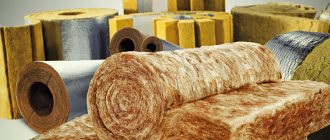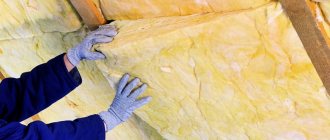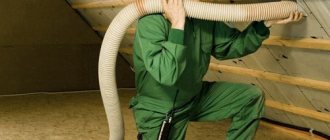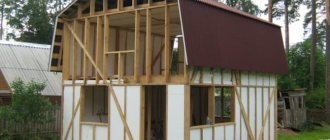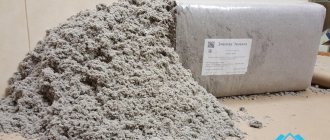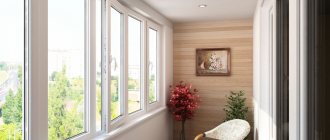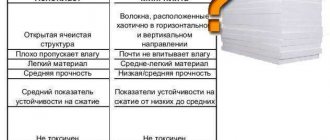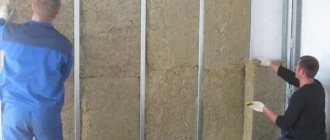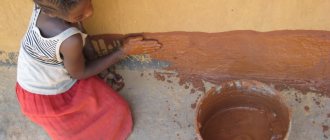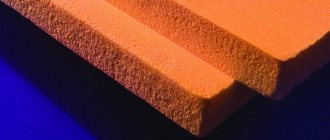What mineral wool is needed in different cases?
When choosing insulation, it is also important to consider the climate of your region.
For example, for walls in areas with a temperate climate, sheets with a thickness of 80 to 100 millimeters are well suited. When the climate shifts towards the continental, monsoon, subarctic, marine or arctic zone, the thickness of the mineral wool should be at least 10 percent greater. For example, for the Murmansk region, insulation from 150 millimeters is best suited, for Tobolsk - 110 millimeters. For surfaces without load in the horizontal plane, a thermal insulation material with a density of less than 40 kg/m3 would be appropriate. This mineral wool in rolls can be used for ceilings or for floor insulation along joists. For external walls of industrial buildings, an option with a coefficient of 50-75 kg/m3 is suitable. Plates for a ventilated facade should be chosen that are denser - up to 110 kilograms per cubic meter, they are also suitable for siding. For plaster, it is desirable to use façade mineral wool with a density of 130 to 140 kg/m3, and for a wet façade – from 120 to 170 kg/m3.
Roof thermal insulation is carried out at heights, so the small mass of insulation and ease of installation are important. Mineral wool with a density of 30 kg/m3 meets these requirements. The material is laid using a stapler or directly into the sheathing using a vapor barrier. In both cases, the insulation layer on top needs finishing. The choice of floor insulation depends on the characteristics of the selected finish. For example, for sheet materials in the form of laminate or boards, thermal insulation with a density of up to 45 kilograms per cubic meter is suitable. A small indicator is quite appropriate here, since there will be no pressure on the mineral wool due to its placement between the joists. You can safely lay thermal insulating mineral material with a density of 200 kg/m3 under a cement screed. Of course, the cost of such insulation is quite high, but it fully corresponds to the quality and ease of installation.
Mineral wool, its properties and main characteristics
Rock wool
Mineral wool is a thermal insulation material that is made from molten glass (glass wool), molten rock (rock wool) and blast furnace slag (slag wool).
Due to the fact that slag wool does not meet the requirements for environmental friendliness, and glass wool is difficult to carry out work using it, stone wool based on basalt is most widespread in frame housing construction.
Basalt stone wool is produced in the form of slabs, which greatly simplifies the process of its installation when insulating frame structures. The only point that needs to be taken into account when constructing the frame is the geometric dimensions of the slabs; they must correspond to the pitch of the vertical posts of the structure. This will make the work easier and avoid waste of material.
Main characteristics of basalt-based mineral wool
For all types of insulation, there are indicators (properties) characteristic of a specific material, which were described above. For basalt slabs, these properties correspond to the following values and indicators:
- Thermal conductivity is low, thermal conductivity coefficient K = 0.032 - 0.048 W/m2.
- Vapor permeability is high, vapor permeability coefficient K=0.49 mg/m*h*Pa.
- The specific gravity is not significant, which makes the work easier.
- Fire safety – high, refers to non-combustible materials. When exposed to an open flame, it does not ignite and does not contribute to its spread. Melting point – more than 1000 *C.
- Environmental friendliness is high, which is achieved by production technology that involves high temperature treatment and the use of natural materials.
- Hygroscopicity is low, the material does not absorb water.
Moisture absorption is less than 2.0% of the insulation’s own weight. - Antiseptic properties – high, not susceptible to rotting and corrosion, as well as the formation of mold and other microorganisms.
- Strength – high, retains its geometric dimensions throughout its entire service life. In addition, this material can withstand significant mechanical loads, the compressive strength is 80 kPa.
- The cost is relatively low.
In addition, mineral wool can act as sound insulation, which is typical for all types of this insulation.
Advantages and disadvantages of using mineral wool
Any building material has its pros and cons, which determine the scope of its use and service life. Mineral wool is no exception in this regard; it also has its own advantages and disadvantages, which can be formulated as follows.
Advantages
- Low thermal conductivity;
- It is not a flammable material;
- High strength and ability to maintain its geometric dimensions;
- Low moisture absorption ability;
- High level of sound insulation;
- Resistance to deformation under the influence of external temperature;
- Resistance to biological and chemical influences;
- Ease of installation work;
- Relatively low cost.
Flaws
- When performing work without protective equipment, damage to the respiratory organs, eyes and skin of the specialist working with this material is possible;
- The service life is somewhat shorter than that of analogues (foam, polyurethane foam).
Choosing the optimal insulation
Mineral wool heat insulators are the most acceptable option for insulating a frame house. The materials are made from different raw materials, which determine the basic characteristics and scope of application. The general advantages of all types of mineral wool include: light weight, fire safety, resistance to pests and the necessary vapor permeability.
The main disadvantage of fiber insulators is hygroscopicity. To preserve the insulation properties, mineral wool needs high-quality vapor and waterproofing.
Basalt wool - environmentally friendly and fireproof
The main component of the insulation is rocks of volcanic origin: basalite, diarite and basalt. Stone wool is a completely non-flammable material that can withstand temperatures of 1000 °C. The heat insulator retains its physical properties for 40-50 years. The main advantages of basalt-based mineral wool:
- low thermal conductivity – 0.36-0.42 W/m*C;
- resistance to mechanical stress;
- good noise insulation characteristics;
- resistance to temperature fluctuations.
The insulation contains hydrophobic additives that ensure rapid removal of moisture. Basalt heat insulator is produced in slabs, the density of the material is 35-50 kg/cubic. m. The disadvantage of stone wool compared to fiberglass counterparts is less elasticity and susceptibility to rodents.
Glass wool – elasticity and moisture resistance
The basic components of the heat insulator are broken glass and sand. The addition of binding components makes it possible to form rolls from the finest glass fibers. Approximate dimensions of the mats: thickness – 100 mm, width – 1200 mm, length – 10 m.
It is equally important to calculate what density of insulation should be used. For thermal insulation of frame buildings, this glass wool parameter should be at least 15-20 kg/cu.m. m.
Features of glass wool:
- high elasticity – the material easily takes on and quickly restores its given shape, which is very convenient during installation;
- vibration resistance;
- not susceptible to mold and unattractive to rodents.
Like rock wool, fiberglass is fire resistant. However, in comparison with the previous insulation, glass wool loses on several points:
- Unsafe material - installation is carried out in a respirator and protective clothing. The fibers are very fragile and when cutting, a lot of “glass” dust is released.
- Shrinkage of the heat insulator - over time, the risk of the formation of cold bridges increases.
Ecowool – versatility of use
A new word in the segment of thermal insulation materials is ecowool. The material is 80% recycled paper. Additional components: boric acid and sodium tetraborate. Minor ingredients provide protection against microorganisms and reduce flammability.
Useful: Wind protection of a frame house
Distinctive features of ecowool:
- Ecowool is a loose insulation material, and therefore the technology for its application is fundamentally different from working with sheet mineral wool. To create a thermal insulation layer, special equipment is required - a pneumatic inflatable device.
- If the walls of a frame house are insulated poorly, there is a risk of ecowool shrinkage , which can lead to the formation of uninsulated zones.
- The material is not recommended for use near open fire sources, fireplace pipes and chimneys. A protective layer of basalt foil-clad fireproof mats or fencing made of asbestos-cement slabs is required.
The main advantages of ecowool: environmental friendliness, the ability to insulate hard-to-reach places and high sound insulation qualities.
“Warm wood” - an alternative to mineral wool
This group is represented by mats and boards made of wood fiber materials . The technical and operational characteristics of the insulation are at a fairly high level:
- good thermal insulation - thermal conductivity is comparable to that of mineral wool;
- preservation of the structure even when wet - the properties of the insulation do not change when absorbing moisture in a volume of 20% of its own weight;
- high strength and excellent sound insulation – protection from impact and “air” noise;
- sufficient density and elasticity - the insulation is attached between the frame posts without additional fasteners;
- environmental friendliness of the material and safety of installation work.
Wood fiber insulation “breathes” and helps maintain a comfortable microclimate in the house. The disadvantages of a heat insulator include: high cost and flammability.
Which insulation to choose?
In order to determine which insulation is best suited, it is necessary to consider the main types.
Basalt wool
Made from numerous basalt rocks. It is supplied in blocks or rolls, making it easy to install. It has characteristics identical to glass wool; in addition to the characteristics already mentioned, it should be added that this kind of insulation can be easily cut without using a specialized strip. At the same time, the material will not become damp and is an excellent insulator.
Touching upon the topic of disadvantages, it is worth mentioning the need to carry out installation work with specialized gloves and goggles to prevent anything from getting on the skin or even in the eye.
Expanded polystyrene
Material made from polystyrene foam with increased rigidity.
It is almost always sold in sheets, and this greatly simplifies installation work. But when working with it, it is difficult to avoid the appearance of cracks, in addition, there is a possibility of cracking, because the material is almost impossible to bend. The disadvantages include flammability. In addition, toxic substances are released during combustion.
Felt
The insulation is made from wool in the form of rolls or mats, and also has a protective coating. It is considered an excellent material for insulating the surface between roof rafters. The second advantage was discovered relatively recently - felt binds aldehydes. The main disadvantage is that very often such insulation is spoiled by rodents or various parasites.
Features of mineral wool
Mineral wool has a number of features:
- excellent thermal insulation qualities;
- non-flammability. If the house catches fire, this insulation will not catch fire, and no harmful substances will be released into the environment. The melting point of the material is above a thousand degrees;
- excellent vapor permeability. Vapors go under the plaster, as well as the insulation, while the condensation that occurs is instantly removed; noise absorption. The structure of such wool is porous, which is why the insulation has excellent acoustic qualities and pronounced noise insulation;
Which insulation is better to choose for a frame house?
When choosing mineral wool insulation, they are guided by the density and, accordingly, thermal conductivity of the material, and its cost. As a rule, the better the insulation retains heat, the higher its cost. Therefore, everyone decides for themselves what type of mineral insulation to choose.
Stone or mineral wool
Mineral wool in rolls or basalt - stone wool in slabs, these are the main materials used in modern construction of frame structures. Basalt - stone wool has a denser crystalline structure, which allows it to retain heat well. In addition, basalt fibers make the heat-insulating material non-flammable and less susceptible to moisture.
| Basalt - stone wool | Mineral wool |
| A fragile material that can break during installation and form harmful dust that not only irritates the skin, but also settles in the lungs | Long soft fibers are very elastic and do not generate harmful dust |
| Practically does not absorb moisture, and even when wet, continues to retain its heat-insulating properties. | It quickly absorbs water and practically does not remove it from its structure, which is why mold and other fungal infections can appear on surfaces. |
| Formaldehyde is used in production | Safe acrylic is used to bind the fibers |
| High resistance to temperature and open flame | There is still a risk of the material catching fire, since acrylic is used for production. |
| Thermal insulation level is high | Thermal insulation level is high |
| Both materials can be successfully used for thermal insulation of rooms in a frame house | |
Insulation of a frame house with mineral wool or basalt slab
What material to choose for insulating a frame house? It can be understood from the above table of the main characteristics of basalt and mineral wool that, in principle, they are both well suited for performing insulation. Basalt wool will be better when insulating a house from the inside, since it has better vapor permeability.
Technologies for insulating walls of frame houses from the inside
Diagram of the construction of frame walls and their thermal insulation
Firstly, for this you need to stock up on the following materials:
- glassine (to create a waterproofing layer);
- beams or metal profiles (for assembling the frame);
- vapor barrier (for example, penofol);
- insulation (let's take mineral wool as an example);
- edged board with a section of 2.5x15 cm and a humidity of no more than 15%.
Secondly, before moving directly to the thermal insulation of the walls, prepare them in this way:
- remove dirt and dust using a broom and vacuum cleaner;
- remove protruding nails (if any);
- dry the walls thoroughly (you can use heaters for this purpose);
- Fill all the cracks with foam.
So, the technology of wall insulation:
Waterproofing. For this, as mentioned above, we use glassine. It is cut into separate strips according to the dimensions of the walls and attached using a construction stapler.
Glassine
A layer of glassine will provide good waterproofing, due to which moisture will be removed from the insulation to the outside of the frame house, which in turn will dry naturally.
Frame assembly. It is made either from beams or from metal profiles (read how to properly construct a frame in our other articles). In principle, everything is visible and clear in the figure.
Wooden frame with insulation already laid
Metal frame using the example of garage insulation
Insulation of a metal or wooden frame. At this stage, the insulating material is laid. In our example, this is mineral wool. It is cut to the required size using a knife and placed between the frame posts.
The principle of laying mineral wool
Do not throw away the remaining mineral wool scraps, but use them as strands laid between the joints of the insulation.
Vapor barrier. A vapor barrier such as penofol 3 mm thick is well suited for mineral wool. It is laid on walls in the same way as glassine. That is, first we cut the penofol into strips with an allowance of 5 cm, and then we overlap and secure with a stapler.
Foil penofol
Covering the walls and thermal insulation layer with edged boards using standard technology.
This, in principle, is the whole scheme for insulating a frame house, or rather its walls.
Internal and external insulation features and nuances
Each insulation option deserves its right to exist, since in some situations it shows better results. The advantages and disadvantages of each method should be analyzed point by point.
Internal insulation has a higher heat retention coefficient, thus energy costs will be minimal.
This is due to the fact that there is no need to warm up the walls; most of the air is retained directly in the room. The situation is twofold, since walls can also collapse due to a shift in the dew point. So the moisture from the cold air will be transformed into droplets almost in the room itself.
Comparison of insulation methods
Also, the internal insulation option is easier to install; you can reach the wall using a simple stepladder.
In contrast to this advantage, there is a nuance - this is a decrease in the variety of wall decor, that is, the insulation is less durable and fastening some structures can be difficult. It is logical that the construction of an additional layer on the walls leads to an overall reduction in the area of the house.
It is highly not recommended to use polystyrene foam and its derivatives due to the synthetic origin of the material and the increased risk of fire. Releases toxins when burned
We recommend paying attention to eco-insulation materials
External insulation is a more standard and safer way to retain heat. This type of insulation has the following advantages:
- The walls are protected from destruction and are less susceptible to weather conditions;
- Does not take up space in the room;
- Lower requirements for the environmental component of insulation;
Wall insulation scheme for a frame house
Insulation of the walls of a frame house can be carried out both outside and inside the house. The materials used for this purpose are the same, the only difference is the thermal insulation technology.
Thermal insulation of external walls
External wall insulation consists of several stages. First of all, the frame is lined with OSB boards on the outside, maintaining a distance between them of 3-4 mm. After that, polyurethane foam is used to fill the cracks. Mineral wool is protected by a waterproofing film that is stretched over its entire surface. Double-sided tape is used to insulate the seams.
Floor insulation scheme for a frame house
The complexity of the work and the peculiarity of floor insulation in frame houses directly depends on the foundation of the building itself. For most of these houses, pile-screw types of foundation are used. Therefore, first of all, when insulating floors, it is necessary to use waterproofing.
Houses located on logs that can be climbed under are insulated with a waterproofing film from below. To install it, you can use a regular stapler. The film is covered on top with cladding boards, which are nailed both closely and at a distance of up to 40 cm from each other.
If the distance from the ground is small, then rows of boards are placed under the logs, on top of which a film is laid from the inside. Mineral wool is placed tightly between the joists on a waterproofing film.
The pitch between the joists should be approximately 58-59 cm, since the standard dimensions of wool slabs are 60 cm wide.
The mineral wool is laid in several layers, its thickness is approximately 15 cm. A vapor barrier film is attached to the top of the mineral wool and the log with double-sided tape. Plywood, OSB or boards are laid on top of the film, so that their edges rest tightly against the walls. Thanks to this, moisture and dust will not enter the house.
Insulating the house from the inside
This process is almost the same as the siding option. Requires a wooden frame and finishing. Walls are often insulated from the inside with mineral wool plus plasterboard. And then there are a lot of finishing options: wallpaper, paint, decorative putty, tiles, plastic panels, lining.
Insulation of internal walls looks like this:
- Surface preparation.
- Frame installation.
- Fixation of the vapor barrier layer.
- Installation of mineral wool (how to install it has already been described).
If there is mold or mildew on the walls, it is important to completely eliminate it. The frame is leveled, mats or rolls are placed in it
Vapor barrier on top. It can be fixed with a stapler. At the end, all that remains is to cover the box with plasterboard and carry out the decorative finishing. This is all done with DIY mineral wool.
Insulating a house with mineral wool: a new step-by-step technology
- The beginning of work on insulating walls with mineral wool involves cleaning the surfaces and treating them with special impregnations that prevent the formation of mold and mildew.
Wood will require impregnation with an antiseptic; brick and aerated concrete surfaces are covered with a layer of plaster and liquid waterproofing.
In addition, you should make sure that the insulated surfaces are dry. Also, all elements that can damage the integrity of the insulation are removed from the walls - window frames and slopes for exterior finishing, fastening and decorative elements when insulating walls from the inside.
- Next, a vapor-permeable membrane is attached to the cleaned wall, with the smooth side facing the insulation.
- At the next stage, a frame made of wood or metal is mounted (you can use a profile for plasterboard). Important! The width of the frame should be slightly smaller (optimally up to 2 cm) than the width of the insulation sheet. The thickness of the frames used should not exceed the thickness of the wool used.
- The body-insulating sheet is placed in the space between the frame guides. With the correct width chosen, there will be no gaps left between the frame and the insulation, which is designed to ensure optimal thermal insulation performance.
- At the next stage, the mineral wool is covered with another layer of vapor-permeable film, which is attached to the frame, and is also attached to the wall using dowels in some places. This provides wind and moisture protection when walls are insulated with mineral wool.
Features of loggia insulation
It is rational to insulate a loggia with mineral wool when a good double-glazed window is installed inside and there is no draft anywhere. Otherwise, such events will be in vain. How to properly insulate a loggia? There are two ways: fixing with glue or creating a frame.
The principle is similar to internal insulation. There are just some difficulties: the surfaces are small, the wool needs to be trimmed and it will take more time to build the frame.
It is noticeable that using mineral wool with your own hands is quite simple. The material is convenient, versatile and good at thermal insulation of private buildings, garages, bathhouses, concrete, brick, wood, and aerated concrete structures. And insulating the walls of a frame house with mineral wool is an excellent option for creating cozy and comfortable housing.
Independent production of thermal protection
Insulating a frame house with mineral wool, namely its step-by-step scheme, will necessarily require the installation of a protective layer from moisture - waterproofing. This is necessary in order to prevent double-sided locking of moisture. Due to its removal to the outside, the walls will get wet and deteriorate.
Waterproofing
The first step will be measuring the dimensions of the surface and cutting the waterproofing material. The material is secured to the posts with a construction stapler. In this case, you need to ensure that the fastening strength is maximum, the frame is completely sheathed around the perimeter. The material should be laid using the overlapping method, the layers should overlap each other by approximately 10 cm.
Vapor barrier
This scope of work is absolutely necessary if hydrophobic materials or those that neutrally tolerate any contact with moisture are used for thermal protection. In addition to them, the so-called cake may also consist of other materials that are more sensitive to getting wet. It would be correct to choose (for internal and external thermal protection) foamed polyethylene or a special film. They are also attached to the racks, this will ensure a good seal to the insulation.
Important note! Wrapping heat insulation blocks in film is a gross violation of the standard method of arranging thermal protection. Until all areas of the frame, without exception, are covered from getting wet, the work cannot be considered complete.
Only after this will it be possible to safely begin work on laying the filler, strictly observing safety regulations.
Stitching
This is the final stage of thermal protection production. For internal surfaces, plasterboard sheets and particle boards remain unrivaled. GCR is best used in cases where the frame is perfectly flat. OSB, due to its rigidity, can be used in the presence of small irregularities. Then you can do the finishing touches.
How is insulation done?
In order to ultimately get a warm frame house, its walls must be insulated from the inside and outside. The work process is almost the same, with a few exceptions.
Insulation from outside
To insulate walls from the outside, it is best to choose the cross method.
The insulation is always laid with the seams staggered to avoid the appearance of blown cracks.
The frame of the building is covered with OSB boards, which should have gaps of 2-3 mm. Subsequently, they need to be foamed.
This is what OSB boards look like
Next, waterproofing is stretched, which protects both the walls of the house and the insulation from moisture and other adverse environmental influences. Usually the waterproofing has self-adhesive strips, if there are none, the knocks between them should be sealed with tape.
Connecting insulation joints
- Each layer of insulation should be laid in such a way as to overlap the previous one by 15-20 cm.
- The thickness of the insulation is approximately 15 cm.
- After laying the insulation, all voids are filled with polyurethane foam.
Insulation of walls inside the house
After the frame house is fully insulated for winter living, you can begin interior decoration. For this:
- The first layer of thermal insulation is laid, the thickness of which is 5 cm.
- Then the insulation is laid in the frame house, the thickness of which is 10 cm. The entire frame between the posts is filled with it.
- Then a vapor barrier is attached, which prevents steam from entering the insulation. They are laid with the rough side outward and the smooth side facing the thermal insulation.
- The bars are installed on top of it.
Insulation is also installed in the partitions between rooms. For the most part, it is required for sound insulation. To do this, slabs are installed with a layer of 10 mm. There is no need for vapor barrier here, since the temperature in the separated rooms will be the same.
Instead of vapor barrier, glassine is used here. It prevents dust from the insulation from entering the room.
Don’t forget about insulating corners in a frame house. This can be done in various ways. So, a warm corner can be made by constructing a structure of two boards, with special stands made of blocks, and the space between such structures can be insulated with mineral wool.
Ceiling insulation
It is better to carry out the work before the roof is completely assembled, so it will not interfere with the density of the installation.
The entire insulation process consists of the following stages:
Inside the house, on the ceiling beams, a vapor barrier is stretched, and a 25 mm thick board is placed on it.
Ceiling beams and vapor barrier
Insulation is laid on top, between which there should be no voids, tightly covering each layer.
- If insulation is not required in the attic, then the membrane film should not be stretched. A board or plywood is nailed to the attic floor.
- If it is not possible to insulate the ceiling from the outside, then this is done inside, and it should be tied up so that it does not fall off. After this, sew on waterproofing, and then on board or plywood.
Indoor ceiling waterproofing
Roof insulation
Often, both the roof and the ceiling in a frame house are insulated. This happens in cases where the attic space is used as a second floor for housing and is heated.
The work process is practically no different from insulating the ceiling. The only exception is that when insulating the roof, waterproofing must be stretched over the material, which will protect it from environmental influences.
Features of roof insulation:
- It is better to insulate from the outside, since doing it inside is inconvenient and unsafe. Many materials tend to crumble on the face.
- After the rafter system is installed, a vapor barrier is sewn underneath, onto which sheathing material, board or plywood is stuffed.
- Sheets of insulation are placed outside. This is done in the same way as when insulating walls, ceilings, etc.
- Waterproofing is placed on top, on which the counter-lattice, sheathing and roofing are installed.
Insulation of the roof inside is carried out only if it is completely assembled.
Roof insulation
Floor insulation
Floor insulation should begin with preparatory work. This should be done before installing the frame of the house.
If the land where the building is located is clay with a high water level, then a water drainage system should be installed.
After this, 40-50 cm of soil is removed inside the foundation and a drainage system is installed. Afterwards it is covered with a sand and gravel cushion. After this, you can install the frame.
Floor insulation
If this step is skipped, you can use expanded clay. To do this, the surface is first leveled, and then the above material is poured. It is desirable that it contains fractions from 10-40 mm. After this, you can arrange the floor.
Thermal insulation with mineral wool: step-by-step instructions
In most cases, mineral wool in the form of mats . Therefore, subsequent instructions will be based on working with this material.
Preparatory activities
The first thing you need to do is understand the structure of the insulation cake, calculate the material and prepare the surface for installation. It doesn’t matter which side to start the work from - outside or inside. Some people believe that it is more convenient to perform thermal insulation from the street side. However, weather factors must be taken into account.
The standard structure of a thermal insulation cake with the order of layers from the internal cladding to the facade of the house:
- Decorative finishing indoors.
- OSB board.
- Vapor barrier.
- Insulation layer.
- Windproof membrane.
- Lathing made of bars for arranging a ventilation gap.
- OSB board.
- External cladding.
The recommended pitch of frame beams is 580-590 mm. This range is optimal when using standard mineral wool mats 60 cm wide. According to the standards, the thickness of the insulation for temperate climates is 150 mm. To fill the space between the beams of 15 cm, it is advisable to use mineral wool of two sizes: 50 and 100 mm.
Surface preparation comes down to cleaning off dust, removing protruding nails and blowing in the cracks with foam between the frame elements. Before attaching the insulation, it is necessary to check the wooden structures for dampness, and dry the problem areas with a hair dryer.
Interior finishing: sequence of layers
First you need to prepare the base for laying the insulation. On the inside of the house, this role will be performed by a vapor barrier film and OSB boards .
Procedure:
- Roll out a roll of insulating material and cut it to the size of the walls of the house.
- Secure the vapor barrier sheets one by one to the vertical posts of the frame using a stapler. Installation rules: the insulating strips are directed perpendicular to the wooden beams, the minimum overlap is 10 cm.
- Check the tightness of the protective layer.
- Cut OSB boards with a jigsaw.
- Secure the panels to the frame, covering the vapor barrier film.
In the future, OSB boards will serve as the basis for applying the final finishing to the walls.
Rules for installing insulation
An important advantage of using mineral wool or wood fiber insulation is the ease of installation with your own hands. Both heat insulators are quite elastic, so they do not require additional fixation. The slabs are inserted between the frame posts and are held in place due to the slight difference in size.
To ensure that the thermal insulation layer does not lose its effectiveness over time, it is necessary to follow certain rules for its installation:
- Laying is done in two layers, the slabs are placed in a checkerboard pattern. The second row of mineral wool should overlap the joining seams of the first in the middle. This technique prevents the appearance of “cold bridges” that contribute to the accumulation of condensation and dampness.
- Insulation boards need protection from strong winds and precipitation. By analogy with the internal wall, the heat insulator is sheathed with a special hydro-windproof membrane.
Useful: Using DSP in a frame house
The film insulation is fixed with a stapler. For more reliable fastening, you can use a counter-latching system.
External wall cladding
The beams attached on top of the wind barrier create the necessary air gap between the thermal insulation material and the exterior finish. Further insulation of the facade depends on the material of the finishing cladding.
Under the block house and siding of various types, moisture-resistant OSB boards are nailed onto the sheathing, to which guide bars are attached. Artificial, natural stone or facade tiles are laid directly on oriented strand boards.
Thermal insulation of a house roof
High-quality roof insulation is of great importance in preserving heat. Thoughtful and well-executed thermal insulation of the roof of a frame house saves 25-30% of thermal energy. A popular insulation option is placing mineral wool between the rafters. The roofing pie must be supplemented with a vapor barrier film and a diffusion membrane.
We will describe sequentially how to properly insulate a roof :
- Stretch a water-repellent diffusion film along the outer end of the rafters. Secure the membrane with a counter-batten.
- Lay insulation on the inside of the rafter system. Thermal insulation is placed in two layers 100 mm thick, the installation pattern is a checkerboard layout.
- Cover the mineral wool with a vapor barrier film, observing the horizontal laying of the vapor barrier in the direction from bottom to top. The overlap of film insulation is 5-10 cm.
- Cover the ceiling with OSB, plasterboard, plywood or clapboard. The external finishing of the roof is done using counter lathing. Sheathing bars are nailed onto the slats, creating a ventilation gap. OSB boards or directly roofing material (slate, corrugated sheeting, metal or flexible tiles) are attached to the top.
Insulation of the first floor floor
A lot of heat also escapes through the foundation of the house - about 15-20% of heat costs fall on the floor. As an option, you can organize water underfloor heating. However, it is easier and cheaper to insulate the base with mineral wool.
Work progress:
- Cover the subfloor with roll waterproofing, maintaining an overlap of 5 cm.
- Fasten the canvases together with reinforcing tape, running it along the joining lines.
- Install a log system made of boards on top of the waterproofing.
- Cut out the insulation for the cells in the joists. The size of the heat insulator should exceed the distance between the boards by 1-2 cm - this gap is necessary for tight joining and eliminating gaps. The thickness of the insulation is at least 200 mm.
- Cover with a vapor barrier film, and lay plywood or a finished plank floor on top.
The described technology is suitable for insulating interfloor or attic floors.
Thermal insulation requirements
There are no capital walls as such in frame structures. All heat-protective functions are performed by multi-layer enclosing structures.
When choosing a thermal insulation material, the basic requirements for insulation for wooden buildings are taken into account:
- environmental Safety;
- fire resistance;
- low thermal conductivity;
- moisture resistance;
- durability.
Products with irregular geometry or damaged corners are not allowed. Do not use materials that have expired. Mineral wool slabs, which have a tendency to caking and high water absorption, are especially sensitive to storage conditions.
Selecting insulation: characteristics of mineral wool
Among the presented types of thermal insulation materials, mineral basalt wool, fiberglass or ecowool are most often used for insulating frame houses. Much less commonly used are polyurethane foam, polystyrene foam, extruded polystyrene foam and expanded clay. Such a high popularity of basalt wool is due to a number of objective reasons, namely:
- environmental friendliness of the material;
- fire safety, withstands temperatures up to 1000°C;
- durability, average service life is about 30 years;
- vapor permeability;
- low thermal conductivity;
- ease of installation.
Basalt mineral wool is a synthetic thermal insulation material. It has high elasticity and resilience, does not burn, and can withstand heavy loads. The disadvantages of mineral wool include:
- The presence of formaldehyde resins and small particles that are harmful to human health;
- Exposure to moisture.
To prevent the release of harmful substances into the air, the insulation on top is tightly covered with a special film, which at the same time serves to protect the mineral wool from moisture and various precipitation. When installing a heat insulator on the walls of a frame house, you should carefully perform not only vapor insulation, but also waterproofing.
This will protect the facades from the appearance of condensation inside the walls, dampness in the room, the development of fungi, changes in temperature conditions and other negative consequences that may occur when the insulation gets wet. It is worth noting that it is preferable to use basalt wool in slabs rather than in rolls for insulating frame houses, since they are denser and when used, the wool does not shrink so much in the wall, forming cracks in the wall.
In addition, it is especially worth highlighting ecowool, which is a safer material than basalt wool, but at the same time, in terms of its thermal insulation and strength characteristics, it is absolutely not inferior to it. Ecowool is a good heat and sound insulator, which is designed for a long service life (about 50-70 years).
Comparison with other materials
Since the wall of a frame house consists of almost 80% insulation, it is necessary to approach its choice consciously. What's the point? Insulation does not heat the house, but it does not allow cold air from outside to penetrate into the rooms, and in addition, it keeps the heated room warm, preventing heated air from leaking out. At the same time, insulation also keeps the frame house cool in intense heat, preventing the room from heating up quickly. Thus, we see that this material turns the home into a kind of thermos that records the optimal temperature inside. Read about the technology for constructing a “framework” here.
Laying mats for insulation
Most often, mineral wool, eco-wool, polystyrene foam and its derivatives are used to insulate walls and frame houses. Mineral wool is a universal material - it does not rot, does not deteriorate, is not subject to decomposition and can retain its characteristics for a long time. Its only disadvantage may be toxicity, especially if you purchased a product from a Chinese manufacturer for a frame building. Modern European materials have long complied with European safety standards and cannot cause any harm.
Mineral wool is also used for insulating floors, roofs, and walls.
A more natural insulation material is ecowool, the main substance of which is paper impregnated with special solutions. Thanks to them, the insulation does not burn or crumple, however, like mineral wool, it is afraid of moisture. That is why it is necessary to produce high-quality overlap waterproofing in frame walls using adhesive tape to reduce gaps to zero.
If you compare mineral wool with polystyrene foam, you will notice that the materials have both their strengths and weaknesses. For example, polystyrene foam is not afraid of moisture, which cannot be said about cotton wool. That is why polystyrene foam is used for external additional insulation, especially in places prone to freezing and condensation in the wall, such as the base.
Comparison of types of insulation
However, when it comes to internal insulation, mineral wool wins - it has no odor, like sheets of foam plastic, which can leave an unpleasant technical smell in the room for several weeks. That is why polystyrene foam is recommended to be used only for external insulation.
Read more about this and other types of insulation here.
Features of using other types of insulation
All preparatory work for thermal insulation of a frame house, regardless of the type of insulation, is no different. The differences, and even then minor ones, are in the installation of the insulation itself, which will be discussed further. Now let's look at the main differences between insulation with other materials, which can also be used as thermal insulation for frame houses.
Insulation with expanded polystyrene (foam) and EPS
If you dig around on the Internet, you will find a lot of controversy about foam insulation not only for wooden houses, but also for others. Indeed, polystyrene foam for frame houses is not the best option, although it will be the warmest, with the same insulation thickness, and why is a separate topic for discussion.
The process of insulation with polystyrene foam and extruded polystyrene foam is practically no different, so they can be combined.
Here are some features of expanded polystyrene and insulation based on it:
- Polystyrene foam does not always fit between the joists as tightly as mineral wool, so all cracks and voids must be removed using polyurethane foam or similar materials.
- Expanded polystyrene is a flammable material; this must be remembered and even potential sources of combustion should not come into contact with it.
- When using polystyrene foam, it is necessary to take care of improved ventilation, because this material practically does not allow air to pass through.
- Despite the fact that polystyrene foam practically does not allow or absorb moisture, it cannot be left as the only waterproofing for the house. Waterproofing and vapor barrier layers must still be present, because they protect not only the insulation, but also the wood itself from which the frame of the house is assembled.
- Expanded polystyrene is very fond of rodents who make their moves in it, so you need to take care that they do not get to it.
These are the basic rules and differences in the use of polystyrene foam boards and insulation based on them. Otherwise, everything is done exactly the same as in the case of insulation with mineral wool.
Features of insulating a frame house with ecowool
Ecowool is a relatively new material for insulating not only frame houses.
It can be used as insulation in almost all areas of private construction, including frame construction.
- Despite the fact that ecowool insulation can be done without special equipment, I still would not recommend doing so. Firstly, because with the help of special equipment ecowool is applied more evenly and blows out all the voids. Secondly, manually prepared ecowool has less good characteristics, both in terms of shrinkage and thermal insulation.
- Ecowool absorbs moisture very well, so waterproofing and vapor barrier materials, as well as their installation, must be approached with special responsibility.
- It is necessary to apply ecowool with a reserve, because it will shrink over time, up to 10-15%.
- When applying it, you must use personal protective equipment.
It is worth noting that when insulating a frame house with ecowool, it is necessary to hire responsible and highly qualified specialists who will take into account all its features during installation.
Insulation of a frame house with expanded clay
This insulation technology is currently used extremely rarely, because there is now a huge selection of materials with much better characteristics.
But still, I will tell you a little about it:
- Expanded clay in dry form, as insulation, can be used either to insulate the floor or ceiling, and it can also be used to insulate interfloor ceilings. Using it in walls is problematic, and, in my opinion, not justified.
- Very often, expanded clay insulation is combined, for example, with sawdust, ash, etc.
- The difference between expanded clay insulation is that the floor and ceiling, underneath the joists, must be pierced either with a board at the joint or with some kind of plywood materials.
- It is better to use expanded clay of a small fraction, thereby there will be fewer voids.
In addition to those described by me, there are many more materials and methods for insulating frame houses with your own hands. But they are all so similar that describing each of them does not make much sense.
Ecowool insulation
This modern material is quite popular due to its environmental friendliness, affordable price and excellent thermal insulation qualities. The thickness of an ecowool layer of 13 cm is equivalent to the thickness of an aerated concrete wall of 60 cm.
Essentially, ecowool is cellulose treated with boric acid (an antiseptic) and borax (a fire retardant). There are three ways to insulate it: in the form of dry backfill, spraying with water or with glue.
The first method is the most inexpensive in terms of budget (equally good for insulating walls, floors and roofs), and therefore the most popular.
Manual ecowool insulation technology
- The easiest way to insulate a horizontal surface in this way. First you need to prepare the material. Ecowool is sold in the form of pressed briquettes weighing 15 kg. After loosening (with an electric mixer or a loosening machine), its volume triples.
- Then ecowool is poured between the joists and distributed evenly, forming a small slide. This is done so that after laying the floorboard it is further compacted.
- To insulate the walls, a vapor barrier or OSB boards (OSB oriented strand boards) are attached to the vertical wooden studs, or plasterboard (gypsum plasterboard) can be used. In this case, there must be a gap at the top through which the material will be laid. At first, ecowool is simply poured into the resulting space, filling it and compacting quite tightly under its own weight. But at the end of the backfill, it will need to be compacted manually.
- You can simplify and speed up the process of insulating ecowool walls of a frame house by using a loosening and blowing installation for installing ecowool, for example, Uralekomaster-650 (UEM-650). But you will have to look for a company that will rent it.
Insulation of frame roof with mineral wool
Frame roof insulation scheme.
For the roof, thermal insulation of the same density is used as for insulating the walls of a frame house with mineral wool (55 kg/m3). It must be understood that the installation of fiber insulators must be carried out during the construction of the roof. Layers from the inside:
- vapor barrier - can be laid on either side;
- thermal insulation - preferably in two layers with offset joints;
- diffusion membrane - fleecy side towards the insulation, smooth side with the logo up;
- counter-lattice - definitely needed to create a ventilated gap;
- roof finishing - tiles, slate, ondulin, corrugated sheets, etc.
Protective films are laid overlapping, and the joints are sealed. They should be tight, without sagging. The membrane is laid from the edge of the roof to the ridge to prevent moisture from entering the seam.
